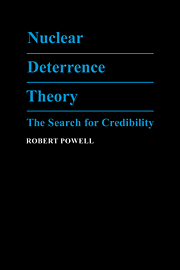Book contents
- Frontmatter
- Contents
- Preface
- 1 Introduction
- 2 The nuclear revolution and the problem of credibility
- 3 The dynamics of nuclear brinkmanship
- 4 Stability and longer brinkmanship crises
- 5 Crisis stability in the nuclear age
- 6 Stability and the lack of control
- 7 The strategy of limited retaliation
- 8 An appraisal
- Appendix Some introductory notes on game theory
- References
- Index
5 - Crisis stability in the nuclear age
Published online by Cambridge University Press: 13 October 2009
- Frontmatter
- Contents
- Preface
- 1 Introduction
- 2 The nuclear revolution and the problem of credibility
- 3 The dynamics of nuclear brinkmanship
- 4 Stability and longer brinkmanship crises
- 5 Crisis stability in the nuclear age
- 6 Stability and the lack of control
- 7 The strategy of limited retaliation
- 8 An appraisal
- Appendix Some introductory notes on game theory
- References
- Index
Summary
Nuclear deterrence theory has generally tried to relate the use of threatened use of force to states' efforts to secure their interests through the strategy that leaves something to chance or the strategy of limited retaliation. At a high level of generality, these strategies approach the relation between force and states' political objectives in fundamentally the same way: Each uses an array of limited options to bridge the gap between doing too much and doing too little. But at a somewhat lower level of generality, these strategies focus on different concerns. The strategy of leaving something to chance begins with the assumption that the sanction is such that it will never be imposed deliberately. That assumption defines the conceptual problem confronting this approach to the credibility problem: to explain how a state might use the threat of such a sanction to further its ends. Schelling's threats that leave something to chance solve this problem, at least in principle, by assuming that the states do not have complete collective control of events (Schelling 1960, pp. 187–203; 1966, pp. 99–105).
But the defining assumption that there is no situation in which the sanction will be imposed deliberately may be very limiting.
- Type
- Chapter
- Information
- Nuclear Deterrence TheoryThe Search for Credibility, pp. 110 - 130Publisher: Cambridge University PressPrint publication year: 1990



